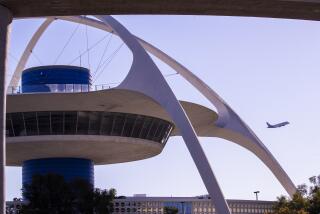Aeromexico Pilot Opts for a Different Flight Path to L.A.
- Share via
Last August, 82 people died when Aeromexico Flight 498, heading for a landing at Los Angeles International Airport, collided with a private plane that was not seen by air traffic controllers over Cerritos.
Last month, Aeromexico Flight 498 narrowly missed a similar tragedy over Cerritos at the same time of day. Another small plane--also not visible on radar screens, according to controllers--came within 500 feet vertically and a half-mile horizontally.
Last weekend, the pilot of another Aeromexico plane flying the same route was not taking any chances.
In a highly unusual move, the pilot departed from the airline’s standard flight plan between Tijuana and Los Angeles and flew a longer zigzag path that allowed him to avoid the airspace where the collision and the near-collision had occurred, it was reported Thursday.
The pilot, who was not identified, formally filed his revised flight plan before taking off from Tijuana, according to Federal Aviation Administration spokeswoman Elly Brekke.
Brekke said that while the plane’s path was unusual for a flight from Tijuana, it is a course often used by planes coming from the interior of Mexico.
Pilots occasionally change courses either before takeoff or during flight because of weather conditions, but it is unusual for such changes to be made without environmental factors, as appeared to be the case in this flight, according to air traffic controllers.
Aeromexico’s assistant regional director, Guy Lionel Arriola, said he did not know the pilot’s motivation and said it did not matter to the airline.
Even if the route is changed simply because it makes the pilot feel safer, “it’s his ship. He’s in total command,” Arriola said.
Anthony Skirlick, a controller at the Los Angeles Air Route Traffic Control Center in Palmdale, which guides jets through Southern California, speculated that the pilot “was very paranoid about going over Cerritos.”
Normally, the Aeromexico flight, which originates in Mexico City, would leave Tijuana, cross over the coast of San Diego and fly inland over Cerritos.
This time, the pilot traveled an extra 50 miles and an extra 10 to 15 minutes.
From Tijuana, he headed east to the San Diego County mountains, then north to Ontario. From there, he headed west to LAX, flying a path similar to jets inbound from Las Vegas.
For all his trouble, the pilot wound up flying only two or three miles north of the crash site. But he was able to do much of his flying over the Los Angeles Basin at a higher altitude because he used a longer direct approach to the airport.
Besides the change in route, there was another dissimilarity between this Tijuana-to-Los Angeles flight and the previous two incidents.
These days, Flight 498 is called Flight 490.
Although airlines usually change flight numbers after collisions, Arriola said the change was made recently because of schedule changes. Aeromexico now runs its Mexico City-to-Los Angeles flights at different times; the schedule under which Flight 498 operated no longer exists, he said.
More to Read
Sign up for Essential California
The most important California stories and recommendations in your inbox every morning.
You may occasionally receive promotional content from the Los Angeles Times.










